Message passing
Interprocess communication (IPC) basically requires information sharing among two or more processes. Two basic methods for information sharing are as follows:
original sharing, or shared-data approach;
copy sharing, or message-passing approach.
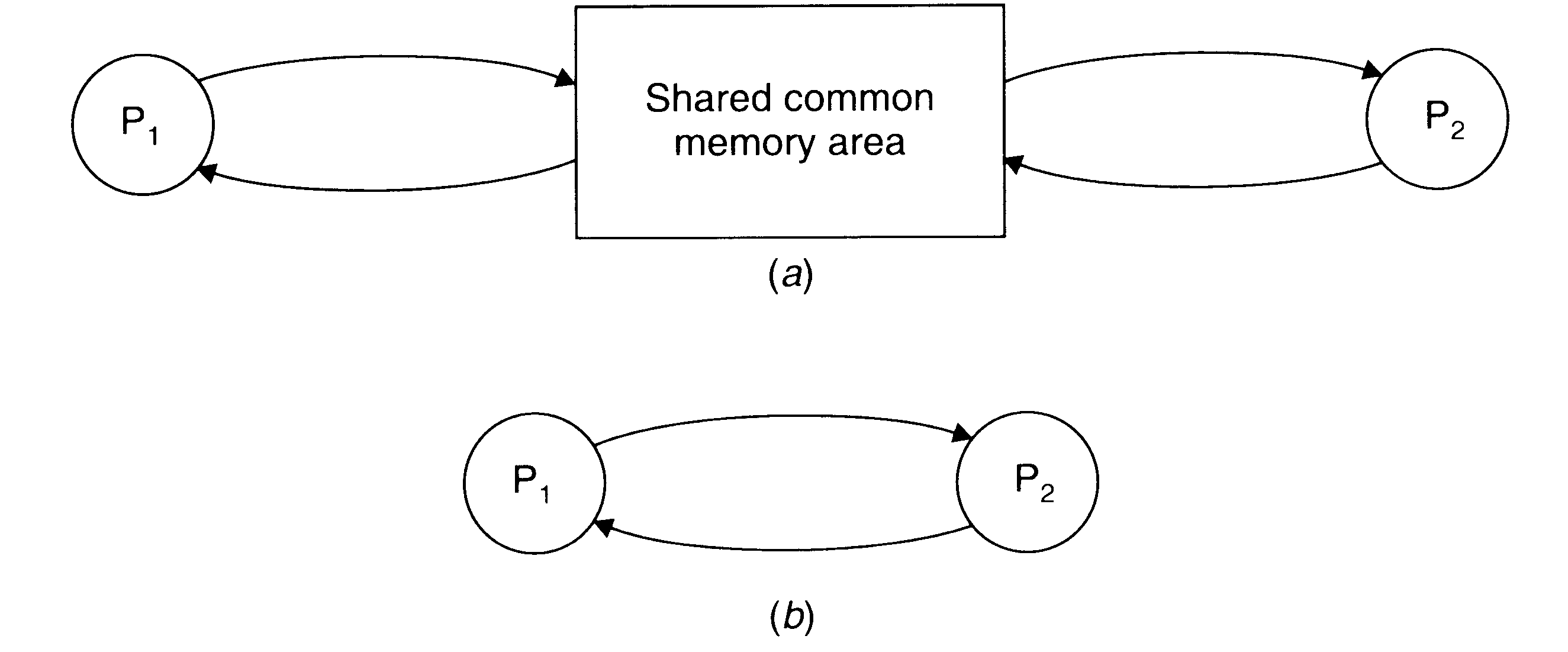
Two basic interprocess communication paradigms: the shared data approach and message passing approach.
A message-passing system is a subsystem of distributed operating system that provides a set of message-based IPC protocols, and does so by shielding the details of complex network protocols and multiple heterogeneous platforms from programmers. It enables processes to communicate by exchanging messages and allows programs to be written by using simple communication primitives, such as send and receive.
Desirable Features of a Good Message-Passing System
Simplicity
Uniform semantics
Efficiency
Correctness
Correctness is a feature related to IPC protocols for group communication. Issues related to correctness are as follows:
atomicity;
ordered delivery;
survivability.
Other features:
reliability;
flexibility;
security;
portability.
Issues in IPC by Message Passing
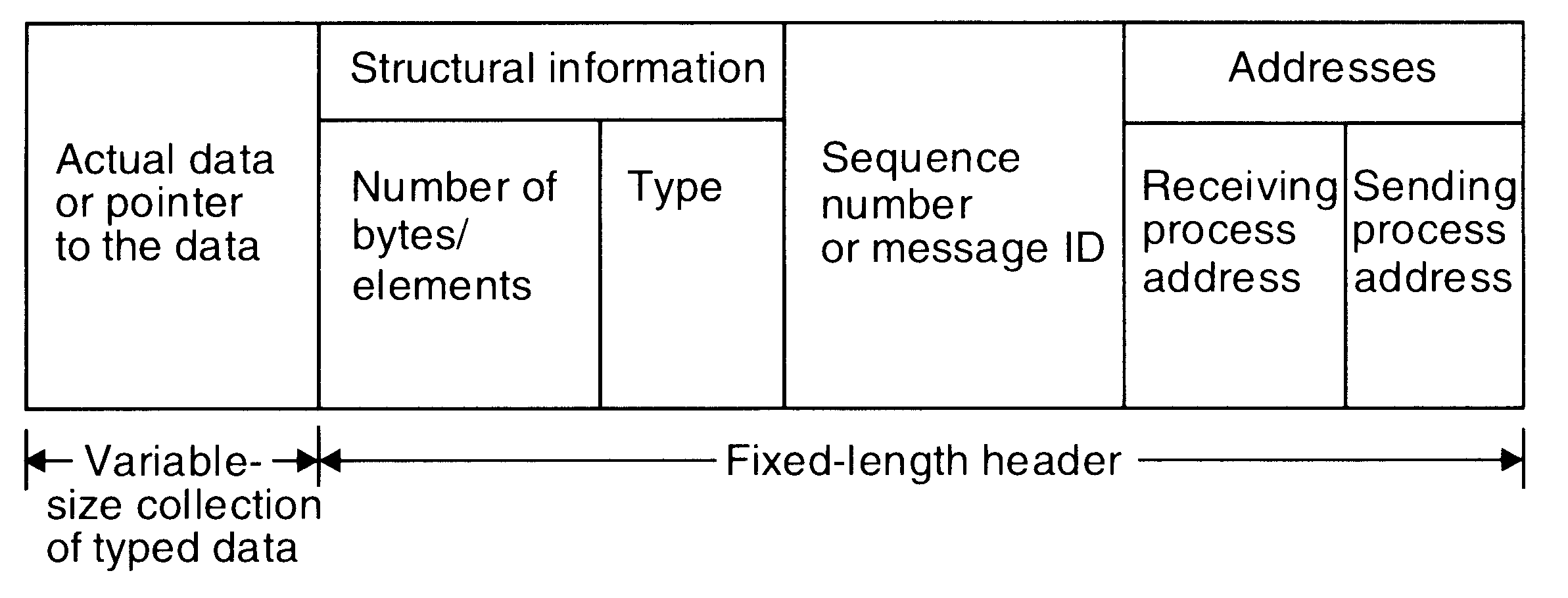
A typical message structure
Synchronization
The semantics used for synchronization may by broadly classified as blocking and nonblocking types. A primitive is said to have nonblocking semantics if its invocation does not block the execution of its invoker (the control returns almost immediately to the invoker); otherwise a primitive is said to be of the blocking type.
A variant of the nonblocking receive primitive is the conditional receive primitive, which also returns control to the invoking process almost immediately, either with a message or with an indicator that no message is available.
When both the send and receive primitives of a communication between two processes use blocking semantics, the communication is said to be synchronous, otherwise it is asynchronous. The main drawback of synchronous communication is that it limits concurrency and is subject to communication deadlocks.
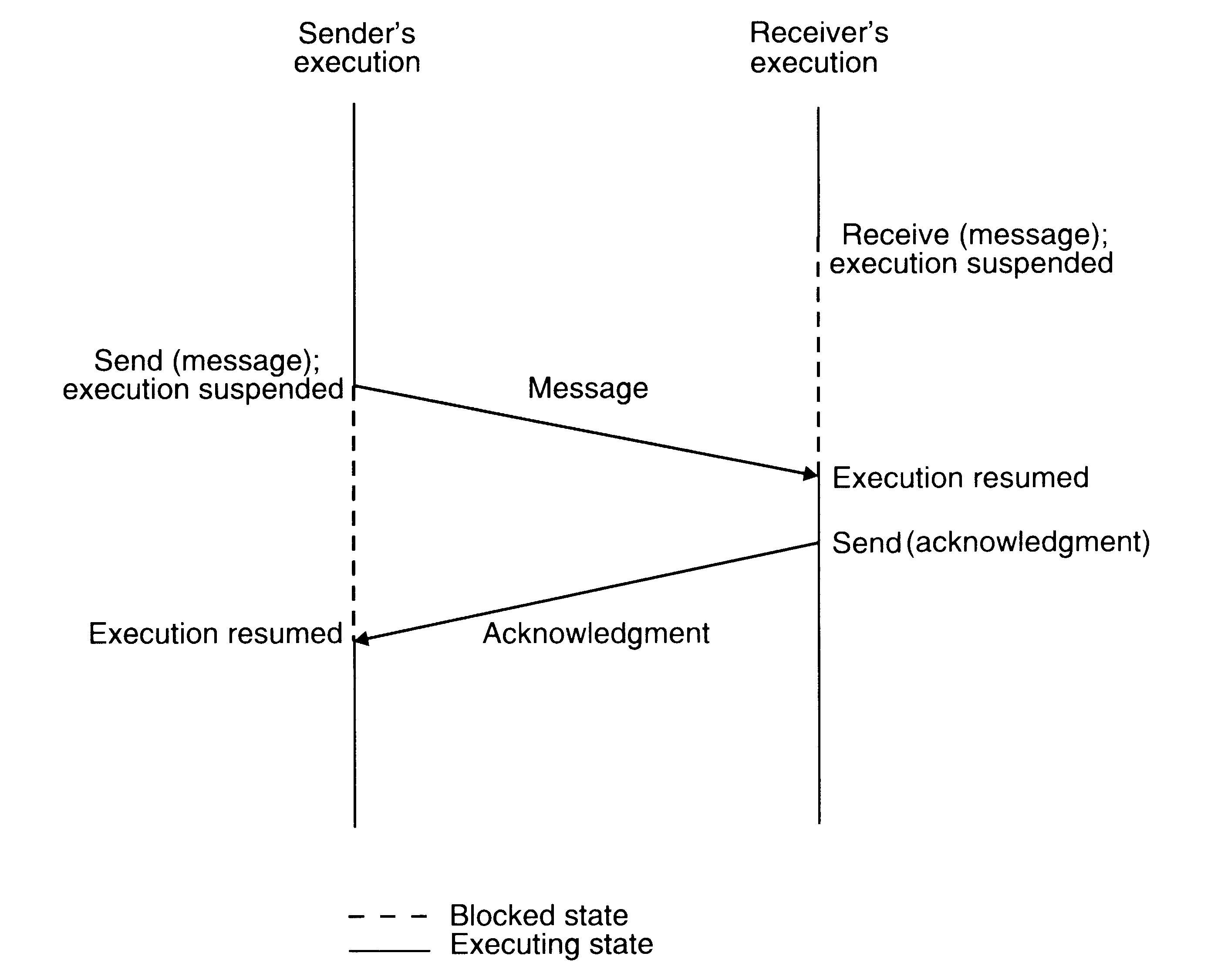
Synchronous mode of communication with both send and receive primitives having blocking-type semantics
Buffering
Null Buffer (No Buffering)
The three types of buffering strategies used in interprocess communication
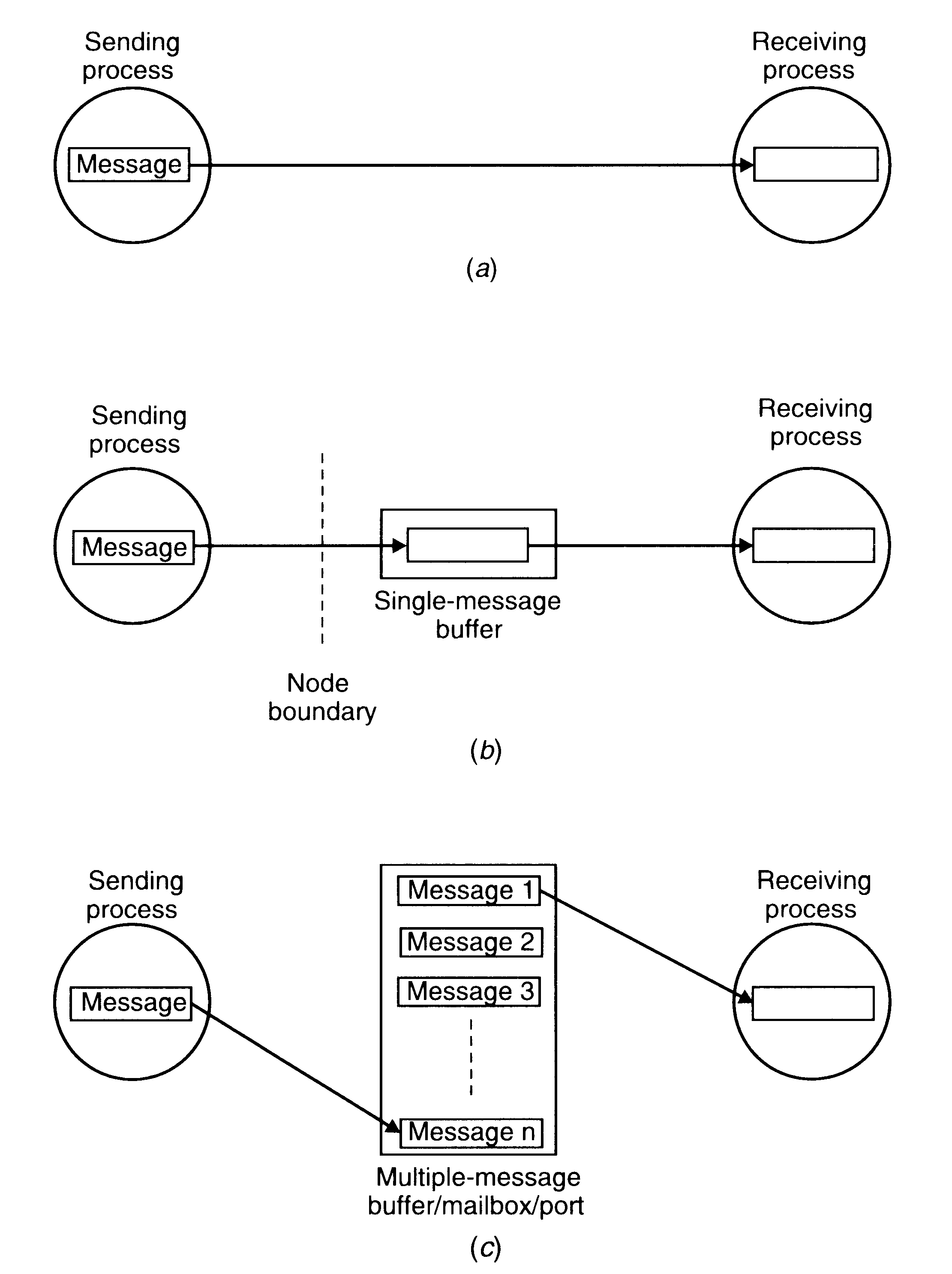
Single-Message Buffer
Unbounded-Capacity Buffer
Finite-Bound Buffer
When the buffer has finite bounds, a strategy is also needed for handling the problem of a possible buffer overflow. The buffer overflow problem can be dealt with in one of the following two ways:
Unsuccessful communication. In this method, message transfers simply fail, whenever there is no more buffer space and an error is returned.
Flow-controlled communication. The second method is to use flow control, which means that the sender is blocked until the receiver accepts some messages, thus creating space in the buffer for new messages.
Multidatagram Messages
Almost all networks have an upper bound of data that can be transmitted at a time. This size is known as maximum transfer unit (MTU). A message whose size is greater than MTU has to be fragmented into multiples of the MTU, and then each fragment has to be sent separately. Each packet is known as a datagram. Messages larger than the MTU are sent in miltipackets, and are known as multidatagram messages.
Encoding and Decoding of Messages
A message data should be meaningful to the receiving process. This implies that, ideally, the structure of program objects should be preserved while they are being transmitted from the address space of the sending process to the address space of the receiving process.
Process Addressing
Explicit addressing. The process with which communication is desired is explicitly named as a parameter in the communication primitive used.
Implicit addressing. The process willing to communicate does not explicitly name a process for communication (the sender names a server instead of a process). This type of process addressing is also known as functional addressing.
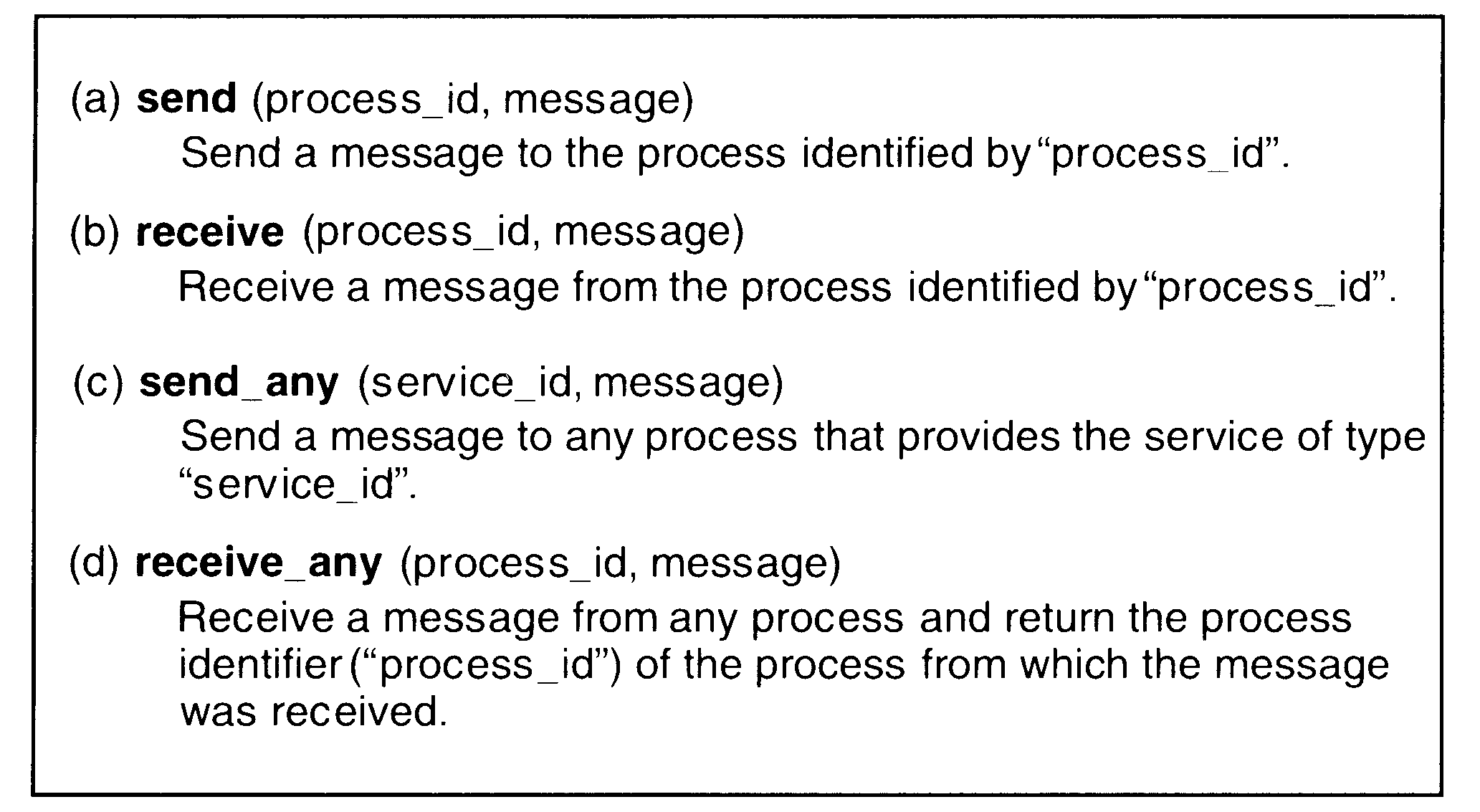
Methods to Identify a Process (naming)
A simple method to identify a process is by a combination of machine_id and local_id. The local_id part is a process identifier, or a port identifier of a receiving process, or something else that can by used to uniquely identify a process on a machine.
To overcome the limitation of the above method, process can be identified by a combination of the following three fields: machine_id, local_id and machine_id.
The first field identifies the node on which the process was created.
The second field is the local identifier generated by the node on which the process was created.
The third field identifies the last known location (node) of the process.
Failure Handling
Loss of request message.
Loss of response message.
Unsuccessful execution of the request.
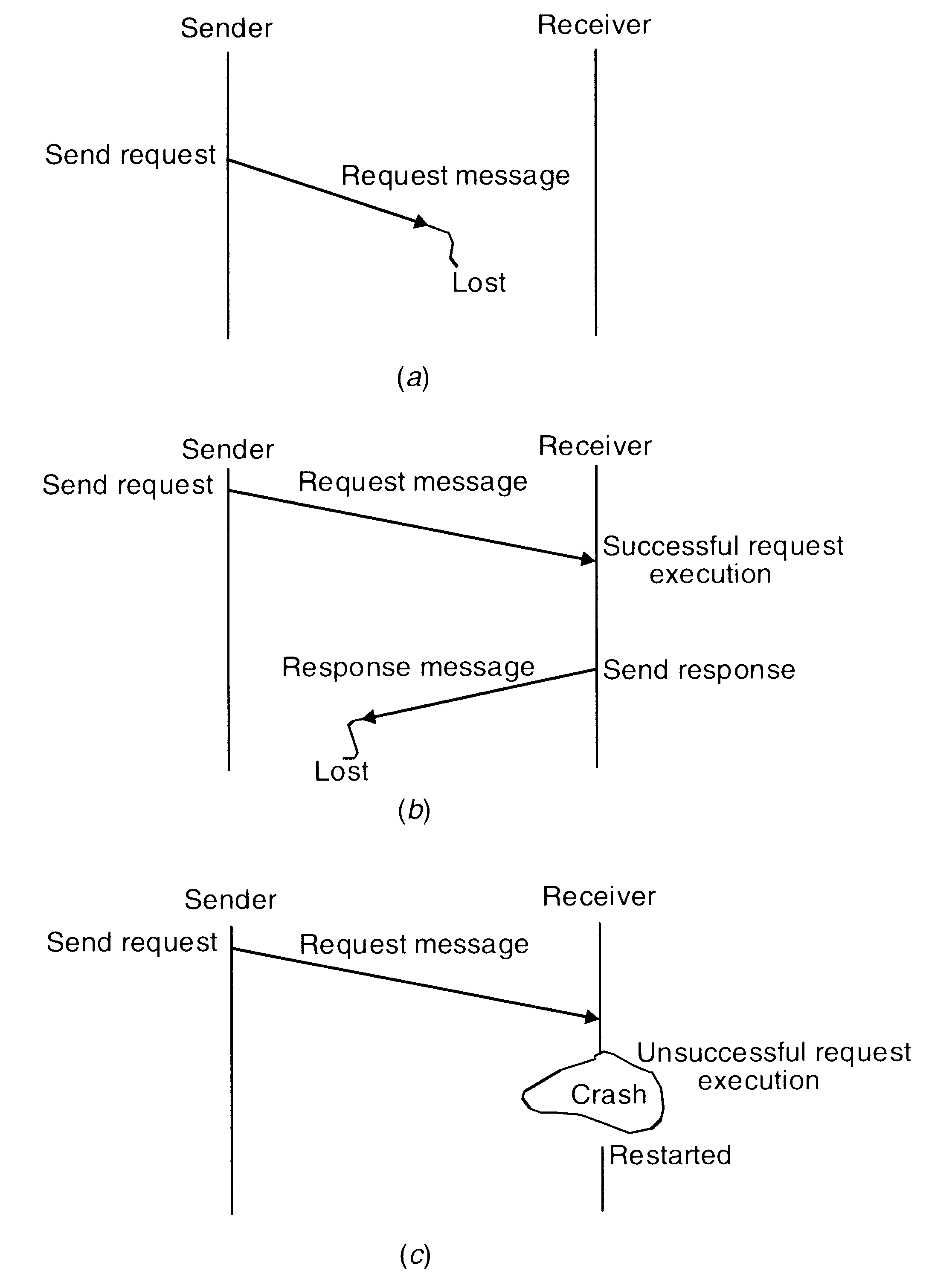
Possible problems in IPC due to different types of system failures
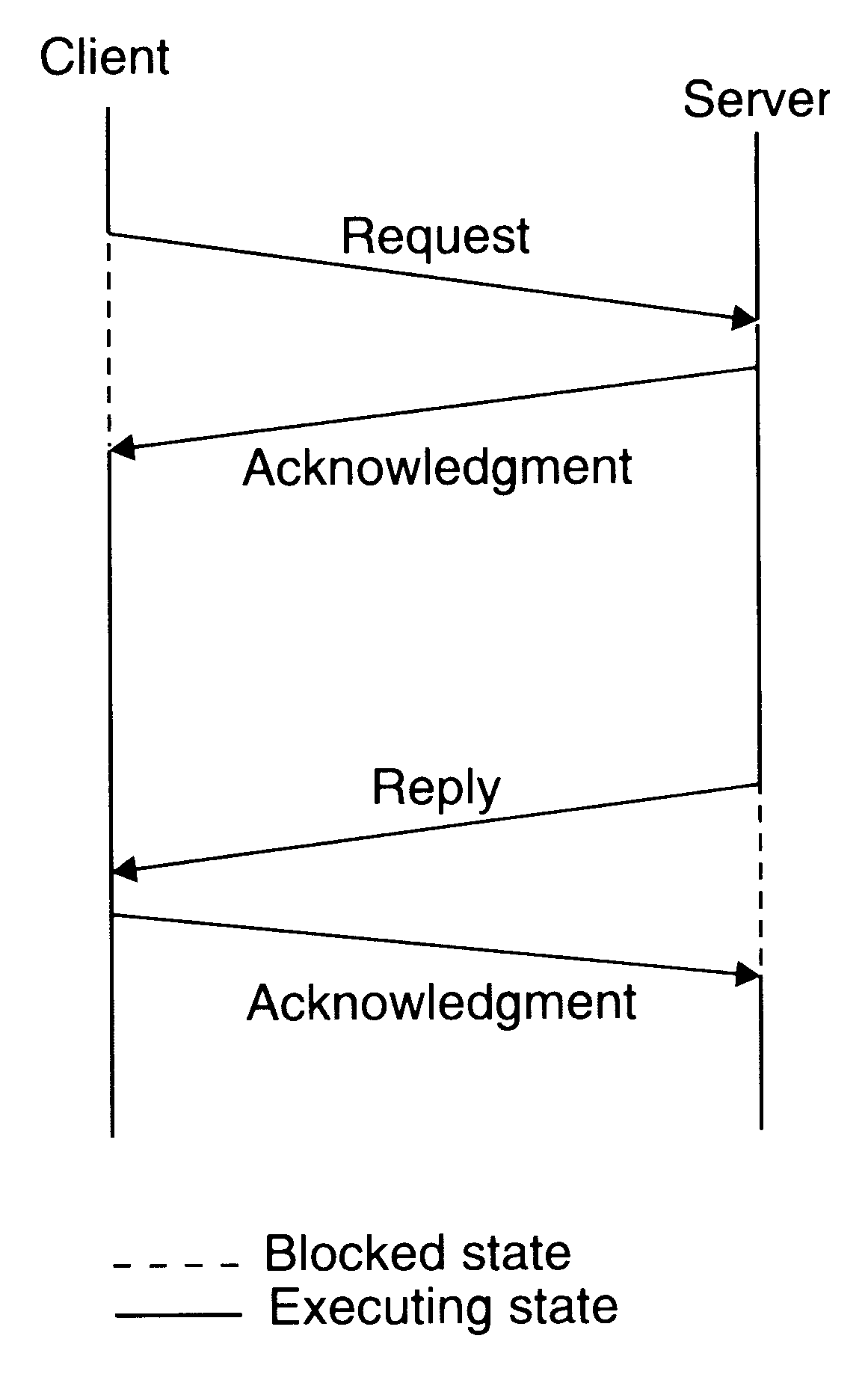
The four message reliable IPC
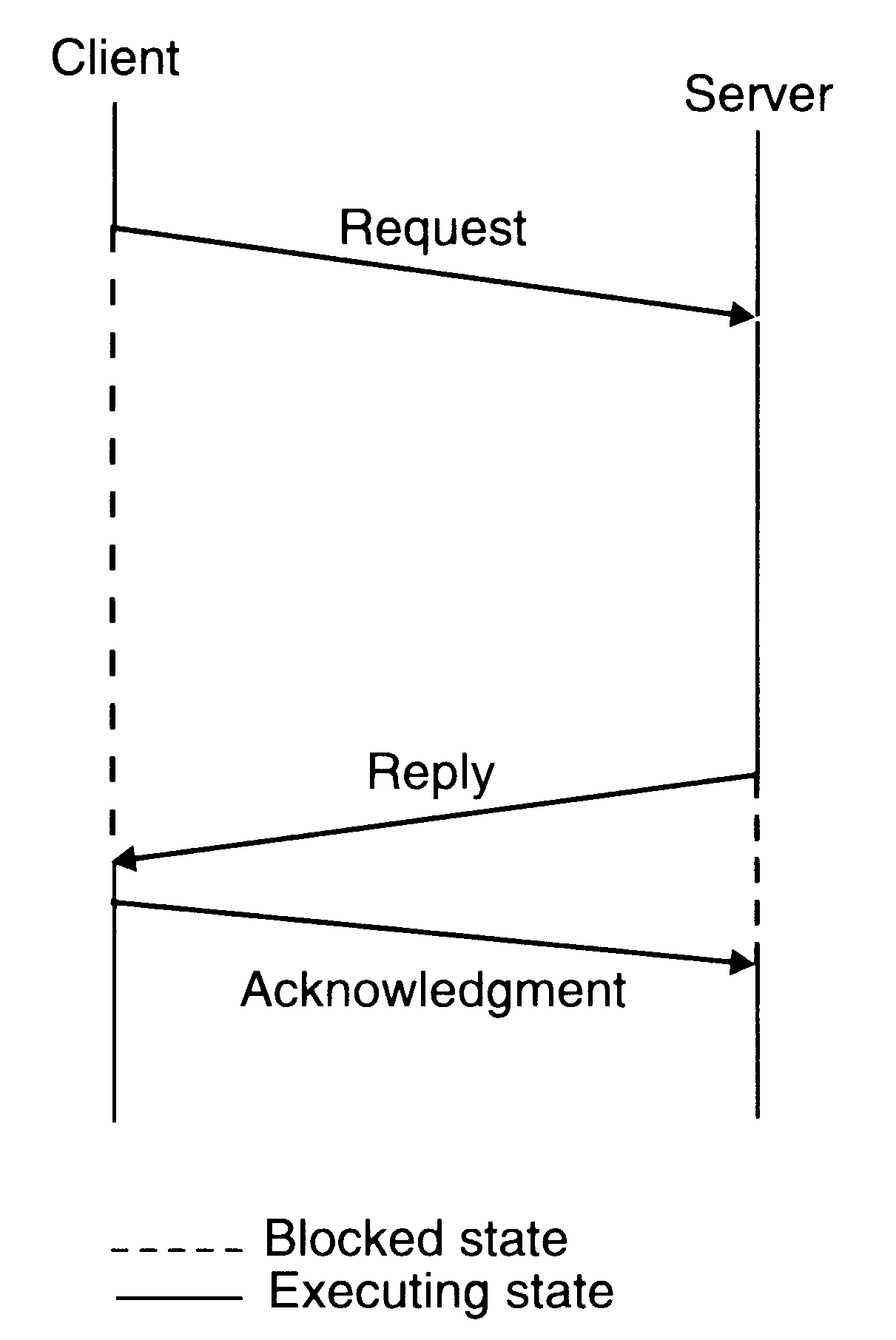
The three message reliable IPC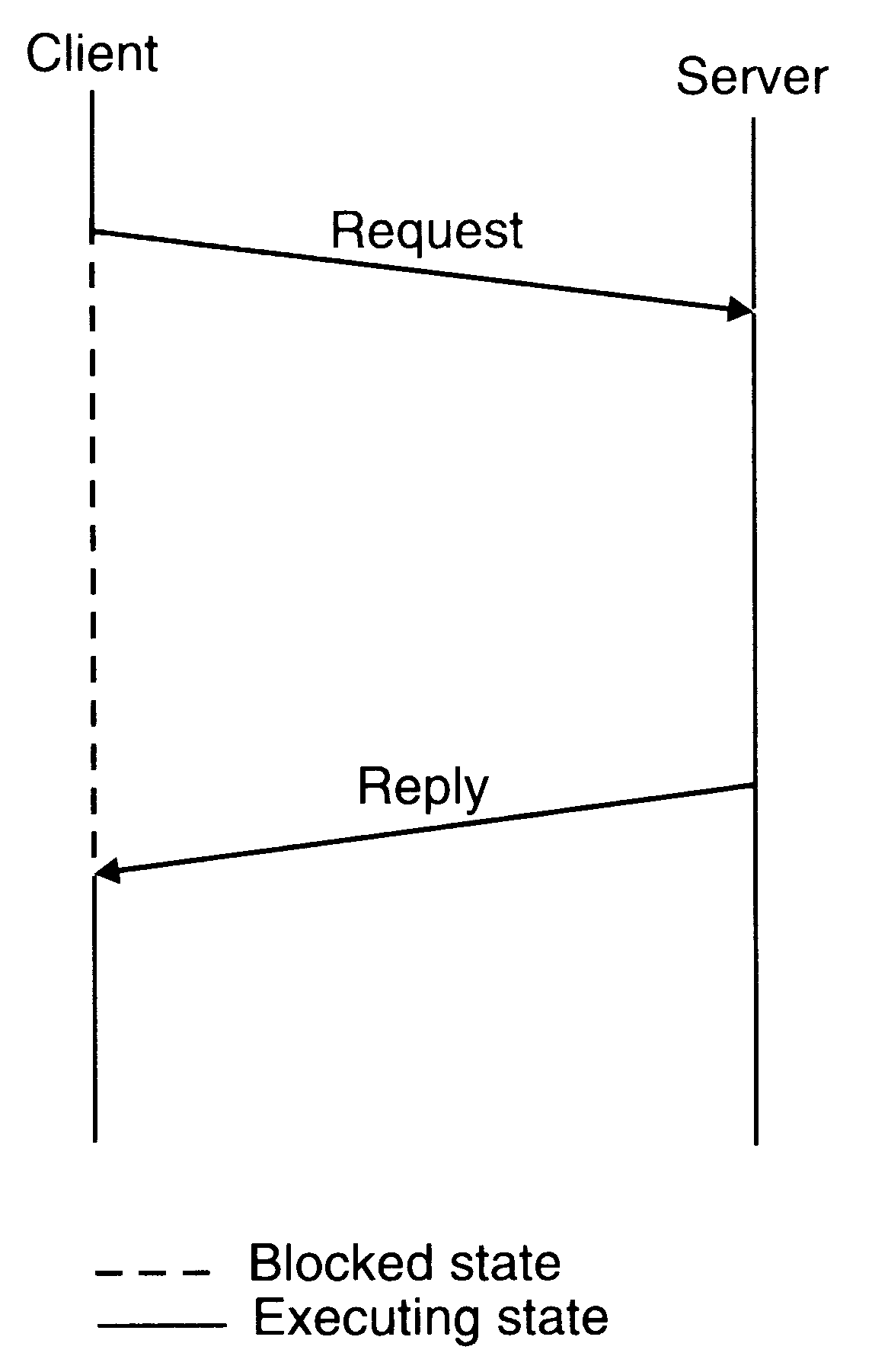
Two message IPC protocol used in many systems for client-server communication
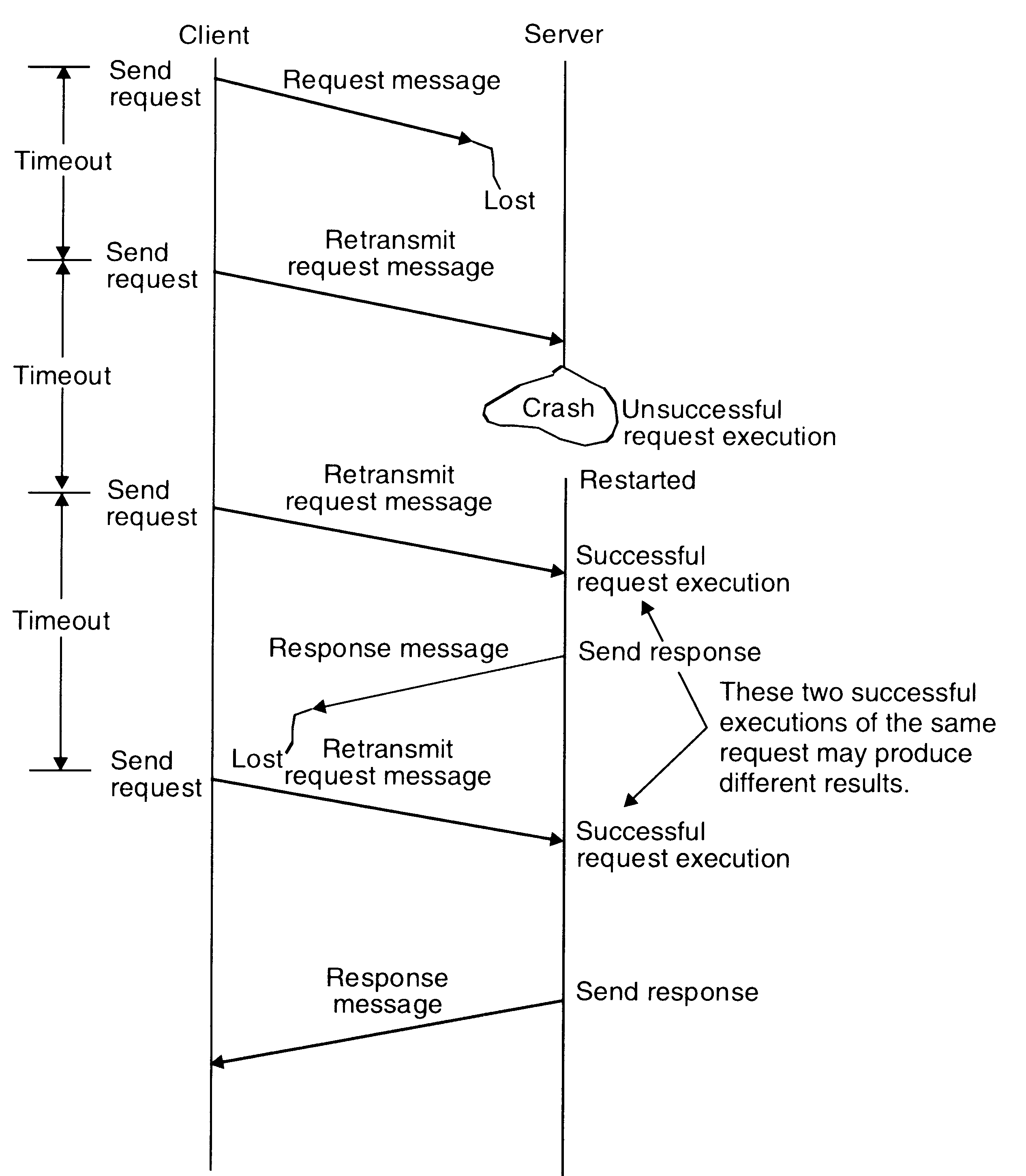
An example of fault tolerant communication between a client and a server.
Idempotency
Idempotency basically means „repeatability”. That is, an idempotent operation produces the same results without any side effects no matter how many times it is performed with the same arguments.
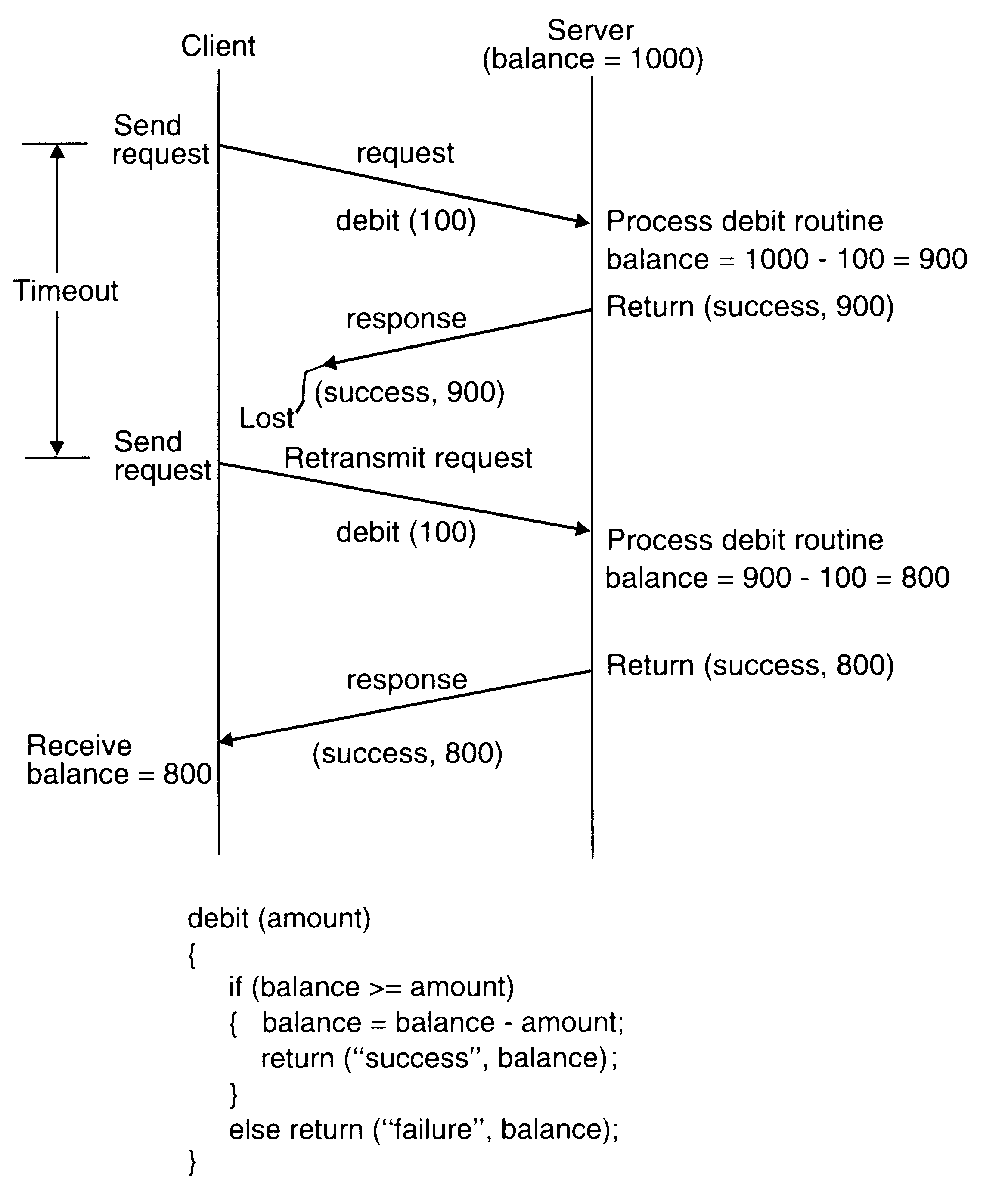
A nonidempotent routine
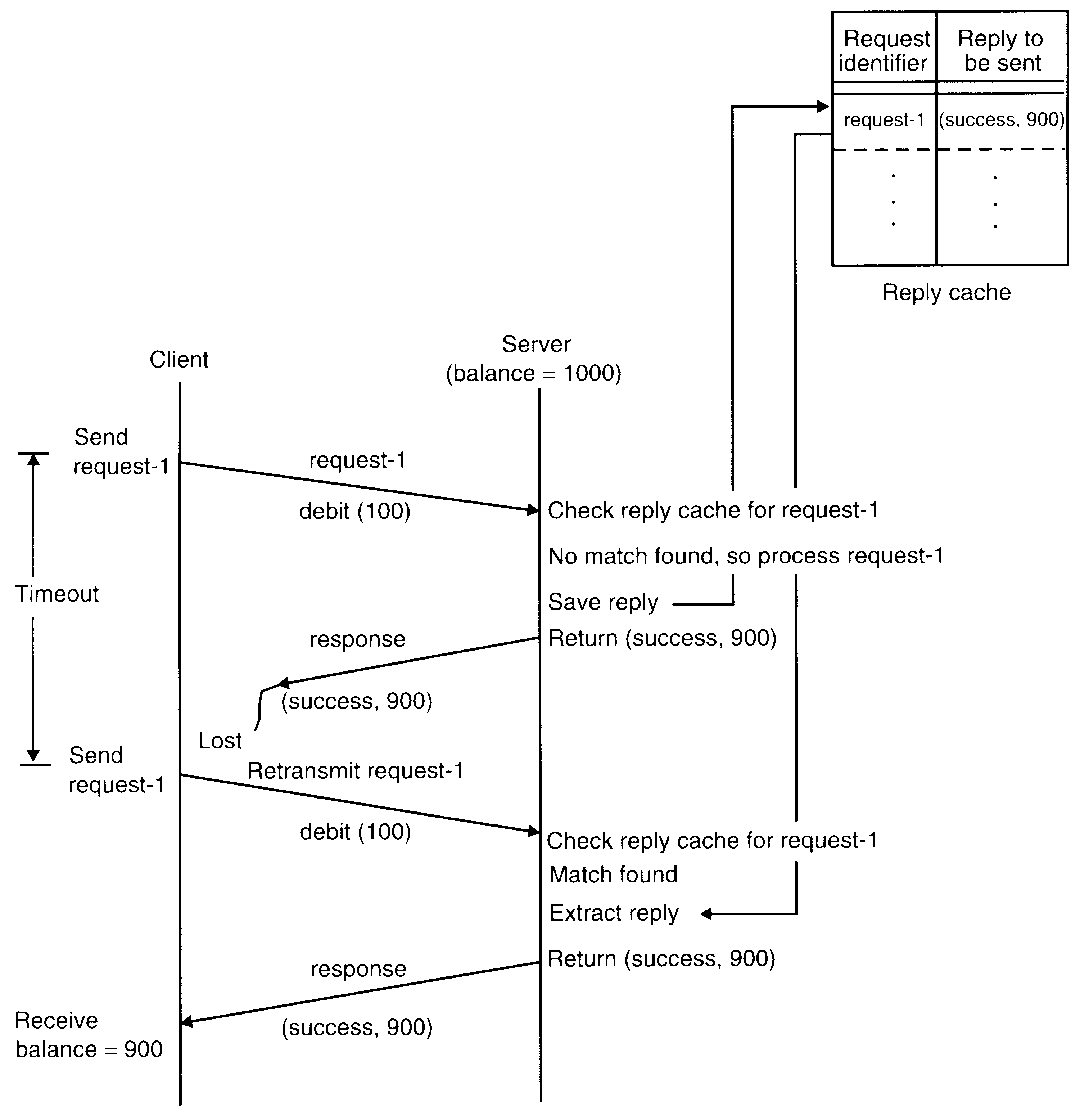
An example of exactly-once semantics using request identifiers and reply cache
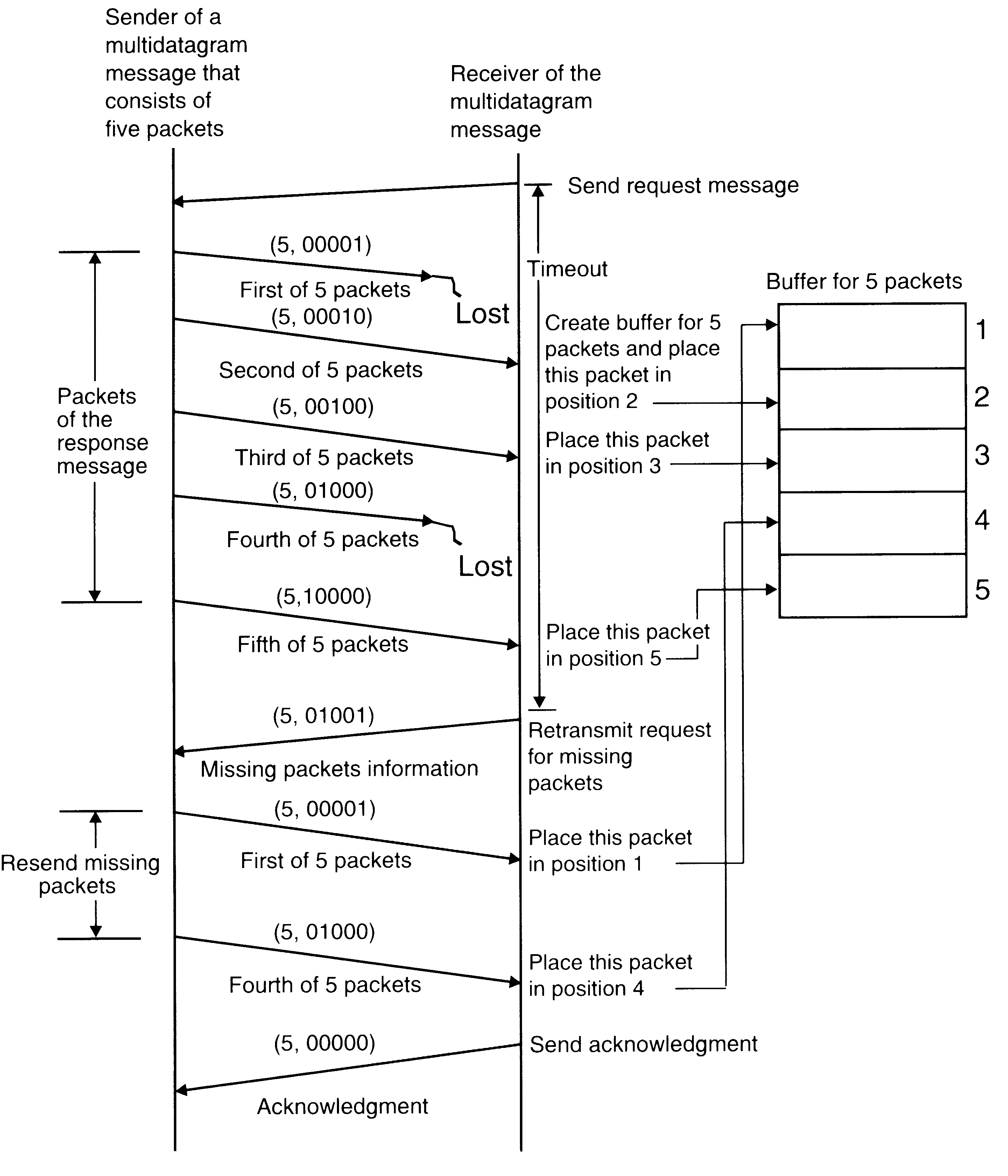
An example of the use of a bitmap to keep track of lost and out of sequence packets in a multidatagram message transmission
Group Communication
One to many (single sender and multiple receivers).
Many to one (multiple senders and single receivers).
Many to many (multiple senders and multiple receivers).
One-to-Many Communication
Group Management
In case of one-to-many communication, receiver processes of a message form a group. Such groups are of two types - closed and open. A closed group is one in which only the members of the group can send a message to the group. An outside process cannot send a message to the group as a whole, although it may send a message to an individual member of the group. On the other hand, an open group is one in which any process in the system can send a message to the group as a whole.
Group Addressing
A two-level naming scheme is normally used for group addressing. The high-level grup name is an ASCII string that is independent of the location of the processes in the group. On the other hand, the low-level group name depends to a large extent on the underlying hardware.
Buffered and Unbuffered Multicast
Multicasting is an asynchronous communication mechanism. This is because multicast send cannot be synchronous due to the following reasons:
It is unrealistic to expect a sending process to wait until all the receiving processes that belong to the multicast group are ready to receive the multicast message.
The sending process may not be aware of all the receiving processes that belong to the multicast group.
Send-to-All and Bulletin-Board Semantics
Send-to-all semantics. A copy of the message is sent to each process of the multicast group and message is buffered until it is accepted by the process.
Bulletin-board semantics. A message to be multicast is addressed to a channel instead of being sent to every individual process of the multicast group.
Flexible Reliability in Multicast Communication
The 0-reliability. No response is expected by the sender from any of the receivers.
The 1-reliability. The sender expects a response from any of the receivers.
The m-out-of-n-reliable. The multicast group consists of n receivers and the sender expects a response from m (1<m<n) of the receivers.
All-reliable. The sender expects a response message from all the receivers of the multicast group.
Atomic Multicast
Atomic multicast (reliable multicast, regular reliable multicast) has an all-or-nothing property. That is, when a message is sent to a group by atomic multicast, it is either received by all the surviving (correct) processes that are members of the group or else it is not received by any of them.
A fault-tolerant atomic (reliable) multicast group protocol must ensure that a multicast will be delivered to all members of a multicast group even in the event of failure of the sender's machine or a receiver's machine.
In the method proposed to solve this problem, each message has a message identifier field to distinguish it from all other messages and a field to indicate that it is an atomic multicast message. The sender sends the message to a multicast group. The kernel of the sending machine sends the message to all members of the group and uses timeout-based retransmissions as in the previous method. A process that receives the message checks its message identifier field to see if it is a new message. If not, it is simply discarded. Otherwise, the receiver checks to see if it is an atomic multicast message. If so, the receiver also performs an atomic multicast of the same message, sending it to the same multicast group. The kernel of this machine treats this message as an ordinary atomic multicast message and uses timeout-based retransmission when needed. In this way, each receiver of an atomic multicast message will perform an atomic multicast of the message to the same multicast group.
Many-to-One Communication
In this scheme, multiple senders send messages to a single receiver. The single receiver may be selective or nonselective. A selective receiver specifies a unique sender; a message exchange takes place only if that sender sends a message. On the other hand, a nonselective receiver specifies a set of senders, and if any one sender in the set sends a message to this receiver, a message exchange takes place.
Many-to-Many Communication
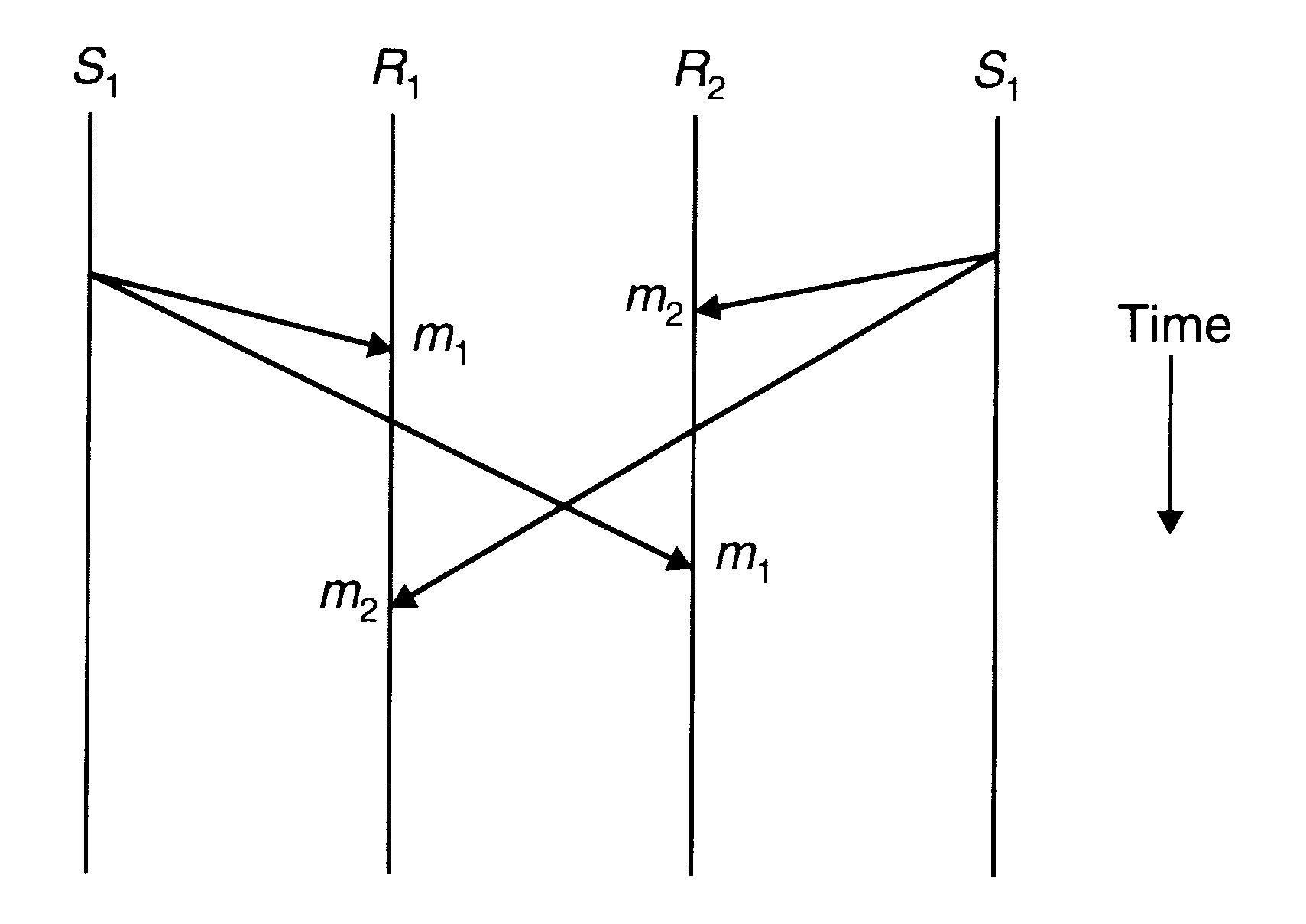
No ordering constraints for message delivery
Absolute Ordering
The absolute ordering semantics ensures that all messages are delivered to all receiver processes in the exact order in which they were sent.
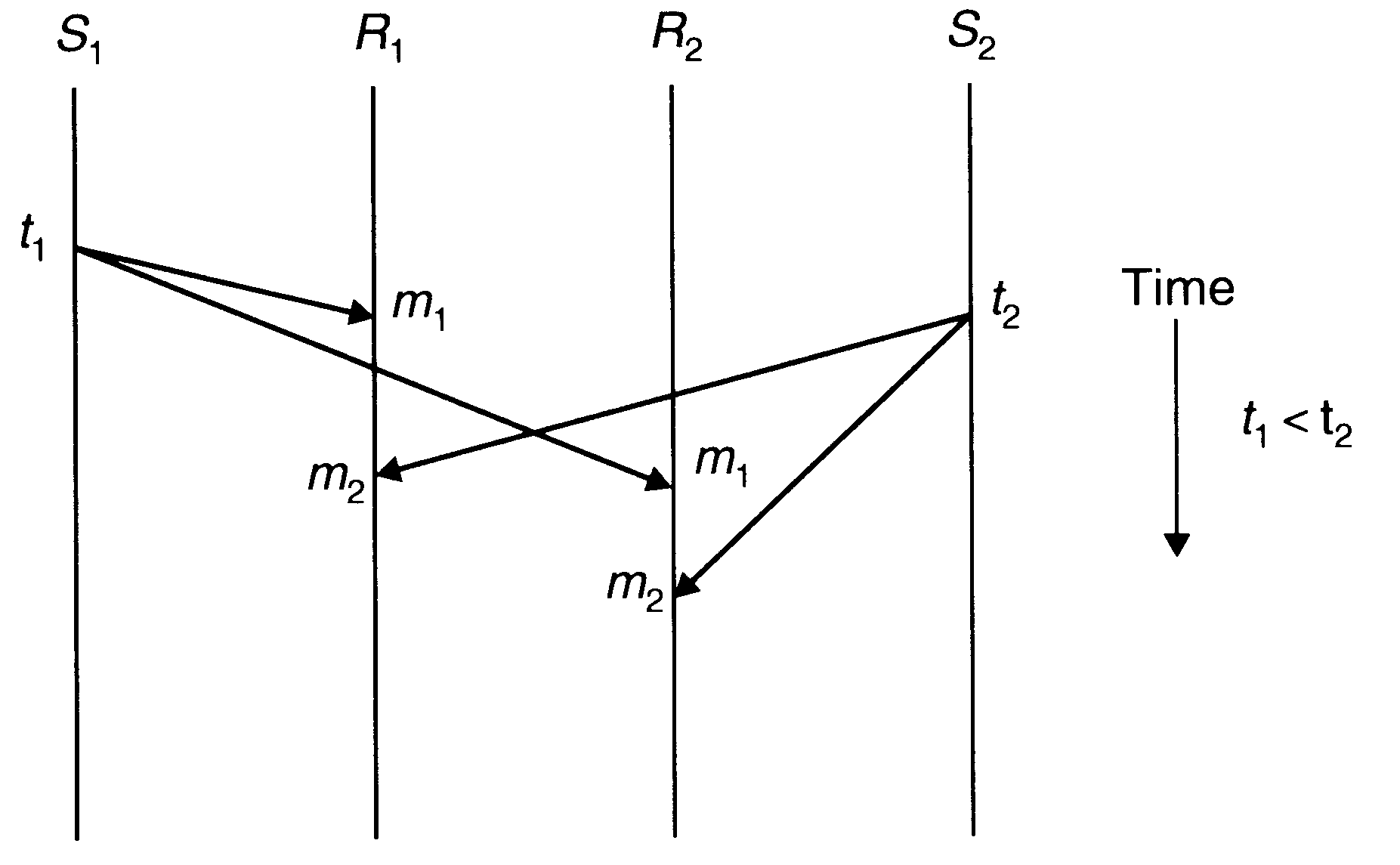
Absolute ordering of messages
To implement absolute ordering semantics, the kernel of each receiver's machines saves all incoming messages meant for a receiver in a separate queue.
A sliding-window mechanism is used to periodically deliver the message from the queue to the receiver. That is, a fixed time interval is selected as the window size, and periodically all messages whose timestamp values fall within the current window are delivered to the receiver. Messages whose timestamp values fall outside the window are left in the queue because of the possibility that a tardy message having a timestamp value lower than that of any of the messages in the queue might still arrive.
Consistent Ordering (Total Ordering)
Instead of supporting absolute ordering semantics, most systems support consistent-ordering semantics (total order semantics). This semantics ensures that all messages are delivered to all receiver processes in the same order. However, this order may be different from the order in which messages were sent.
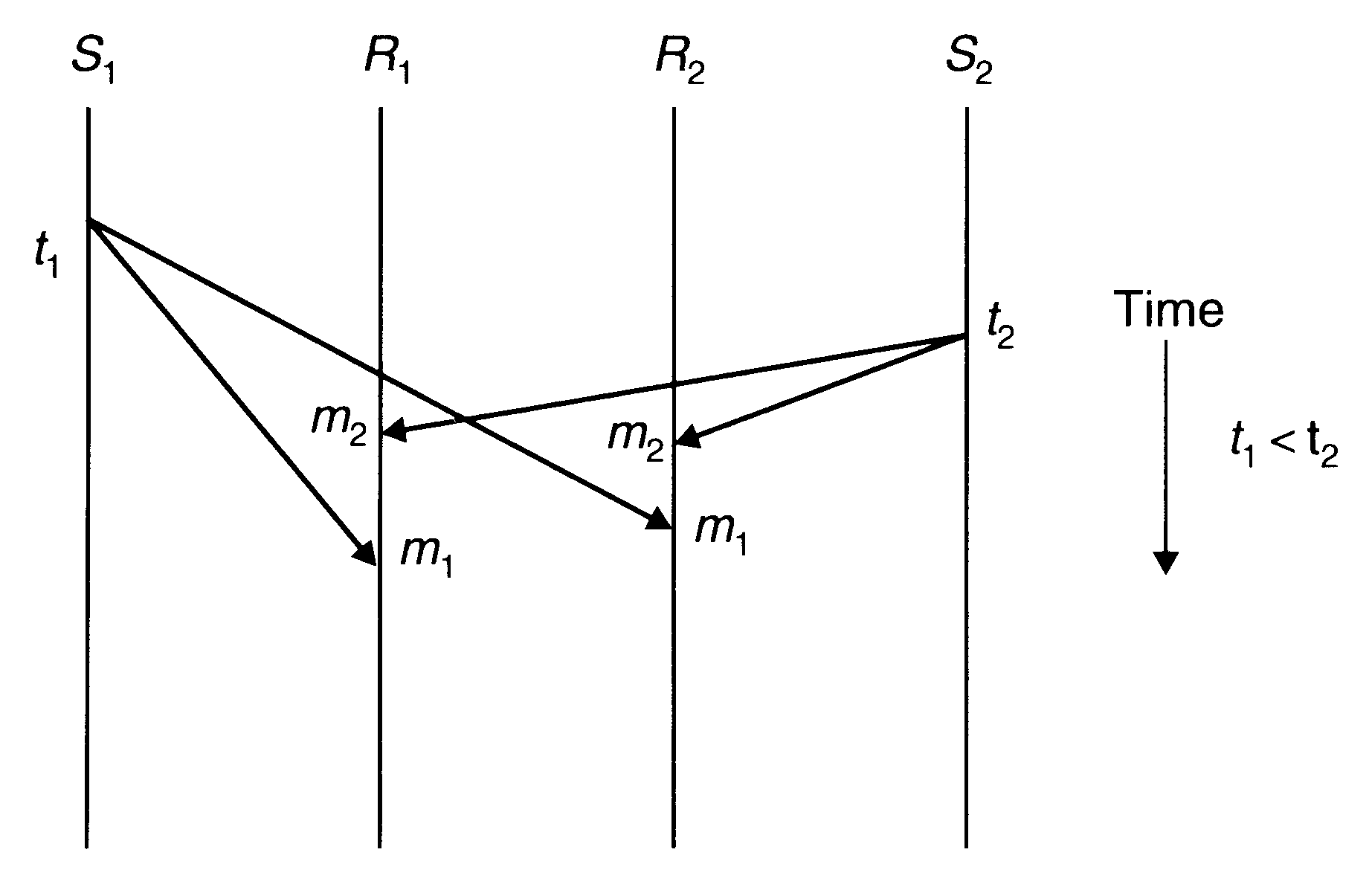
Consistent ordering of messages
One method to implement consistent-ordering semantics is to make the many-to-many scheme appear as a combination of many-to-one and one-to-many schemes. That is, the kernels of the sending machines send messages to a single receiver (known as sequencer) that assigns a sequence number to each message and then multicasts it.
A distributed algorithm for implementing consistent-ordering semantics that does not suffer from this problem is the ABCAST protocol of the ISIS system. It assigns a sequence number to a message by distributed agreement among the group members and the sender and works as follows:
The sender assigns a temporary sequence number (integer) to the message and sends it to all members of the multicast group. The sequence number assigned by the sender must be larger than any previous sequence number used by the sender. Therefore, a simple counter can be used by the sender to assign sequence numbers to its messages.
On receiving the message, each member of the group returns a proposed sequence number to the sender. A member (i) calculates its proposed sequence number by using the function: Max(Fmax, Pmax)+1+i/N, where integer Fmax is truncated the largest final sequence number agreed upon so far for a message received by the group (each member makes a record of this when a final sequence number is agreed upon), integer Pmax is truncated the largest proposed sequence number by this member, and N is the total number of members in the multicast group.
When the sender has received the proposed sequence number from all the members, it selects the largest one as the final sequence number for the message and sends it to all members in a commit message. The chosen final sequence number is guaranteed to be unique because of the term i/N in the function used for the calculation of a proposed sequence number.
On receiving the commit message, each member attaches the final sequence number to the message.
Committed messages with final sequence numbers are delivered to the application programs in order of their final sequence numbers.
Causal Ordering
A weaker ordering semantics that is acceptable to many applications is the causal ordering semantics. This semantics ensures that if the event of sending one message is causally related to the event of sending another message, the two messages are delivered to all receivers in the correct order. However, if two message-sending events are not causally related, the two messages may be delivered to the receivers in any order. Two message-sending events are said to be causally related if they are correlated by the happened-before relation.
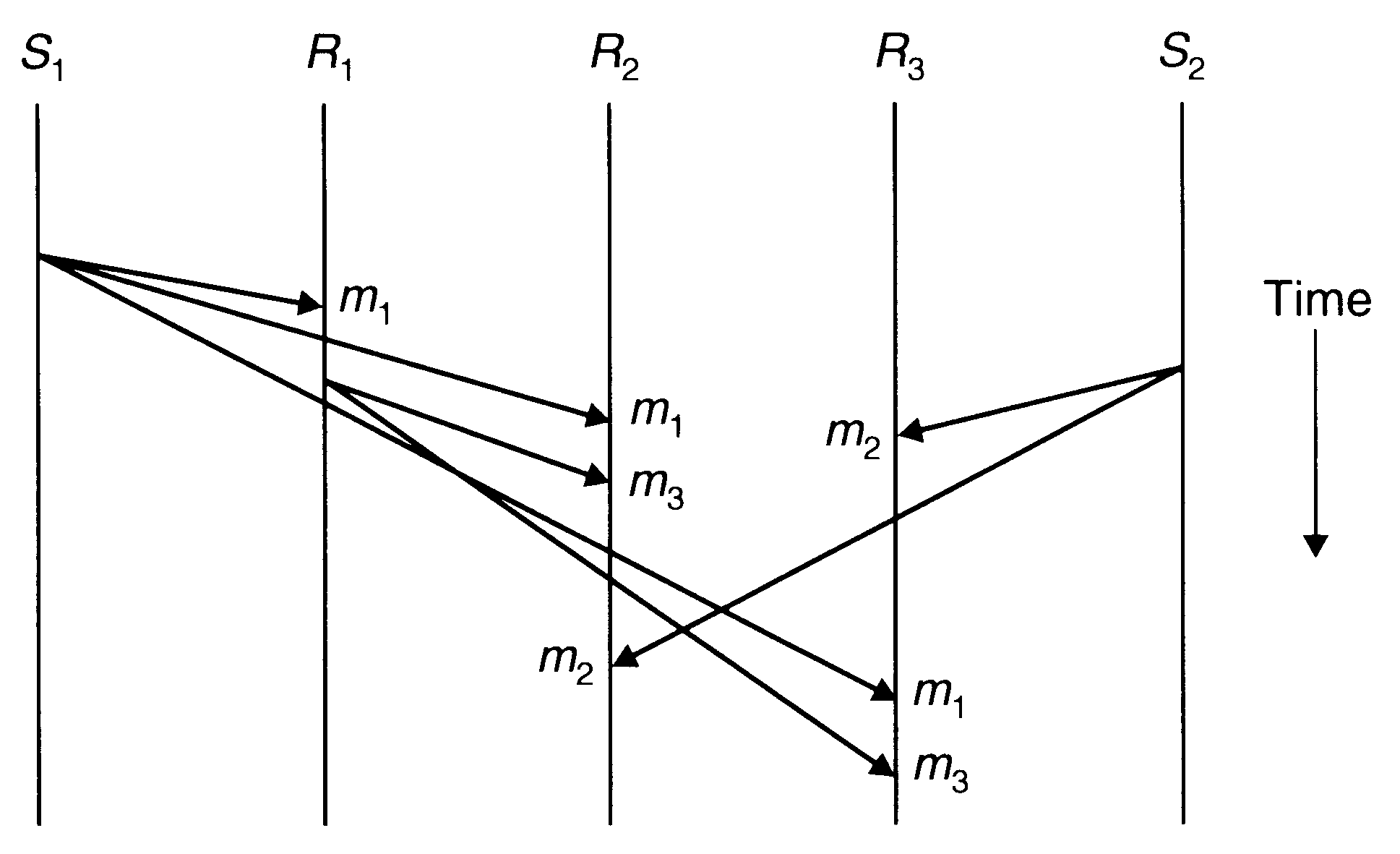
Causal ordering of messages
One method for implementing causal-ordering semantics is the CBCAST protocol of the ISIS system. It assumes broadcasting of all messages to group members and works as follows:
Each member process of a group maintains a vector of n components, where n is the total number of members in the group. Each member is assigned a sequence number from 0 to n-1, and the i-th component of the vectors corresponds to the member with sequence number i. In particular, the value of i-th component of a member's vector is equal to the number of the last message received in sequence by this member from member i.
To send a message, a process increments the value of its own component in its own vector and sends the vector as part of the message.
When the message arrives at a receiver process's site, it is buffered by the runtime system. The runtime system tests the two conditions given below to decide whether the message can be delivered to the user process or its delivery must be delayed to ensure causal-ordering semantics. Let S be the vector of the sender process that is attached to the message and R be the vector of the receiver process. Also let i be the sequence number of the sender process. Then the two conditions to be tested are:
S[i]=R[i]+1
S[j]<=R[j] for all j not equal i
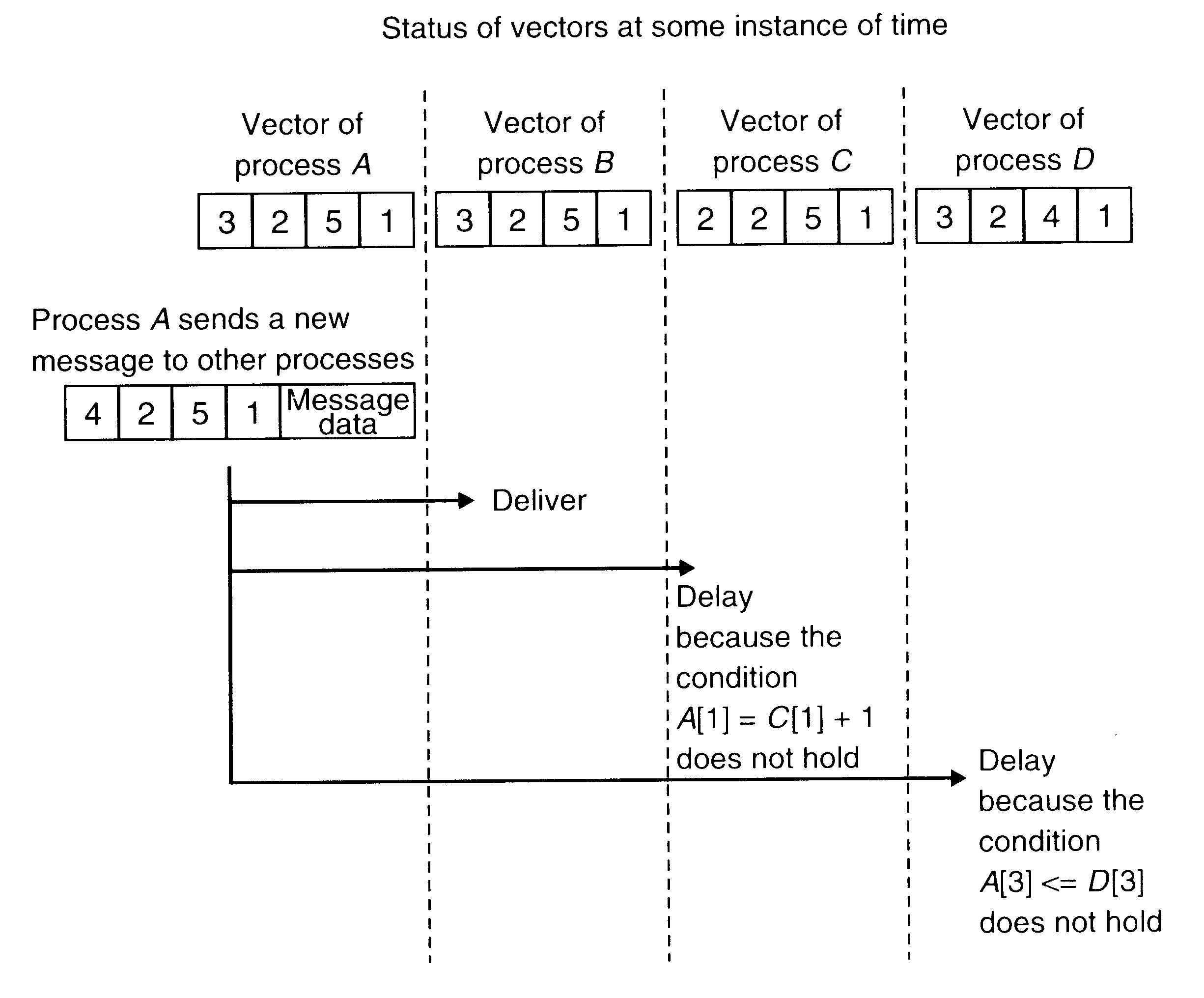
An example to illustrate the CBCAST protocol for implementing causal ordering semantics
Formal Broadcast Specifications
Reliable Broadcast
Reliable Broadcast is a broadcast that satisfies the following three properties:
Validity: If a correct process broadcasts a message m, then all correct processes eventually deliver m.
Agreement: If a correct process delivers a message m, then all correct processes eventually deliver m.
Integrity: For any message m, every correct process delivers m at most once, and only if m was previously broadcast by sender(m).
FIFO Broadcast
FIFO Broadcast, a Reliable Broadcast that satisfies the following requirement on message delivery:
FIFO Order: If a process broadcasts a message m before it broadcasts a message m′, then no correct process delivers m′ unless it has previously delivered m.
Causal Broadcast
An execution of a broadcast or deliver primitive by a process is called an event. We say that event e causally precedes event f, denoted e → f, if and only if:
a process executes both e and f, in that order, or
e is the broadcast of some message m and f is the delivery of m, or
there is an event h, such that e → h and h → f.
A Causal Broadcast is a Reliable Broadcast that satisfies the following requirements:
Causal Order: If the broadcast of a message m causally precedes the broadcast of a message m′, then no correct process delivers m′ unless it has previously delivered m.
Total Order (Atomic) Broadcast
A Total Order (Atomic) Broadcast is a Reliable Broadcast that satisfied the following requirement:
Total Order; if correct processes p and q both deliver messages m and m′, then p delivers m before m′ if and only if q delivers m before m′.
FIFO Atomic Broadcast
FIFO Atomic Broadcast is a Reliable Broadcast that satisfies both the FIFO and Total Order requirements.
Causal Atomic Broadcast
Causal Atomic Broadcast is a Reliable Broadcast that satisfies both the Causal and Total Order requirements.
Timed Broadcasts
(Real-Time) Δ-Timeliness: There is a known constant Δ such that if the broadcast of m is initiated at real time t, no correct process delivers m after real-time t + Δ.
(Local-Time) Δ-Timeliness: There is a known constant Δ such that no correct process p delivers a message m after local time ts(m) + Δ on p's clock.
A broadcast that satisfies either version of the Δ-Timeliness property is called a Timed Broadcast.
Uniform Broadcasts
Uniform Agreement: If a process (whether correct or faulty) delivers a message m, then all correct processes eventually deliver m.
Uniform Integrity: For any message m, every process (whether correct or faulty) delivers m at most once, and only if some process broadcast m.
Uniform Local-Time Δ-Timeliness: There is a known constant Δ such that no process p (whether correct or faulty) delivers a message m after local time ts(m) + Δ on p's clock.
Uniform FIFO Order: If a process broadcasts a message m′, then no process (whether correct or faulty) delivers m′ unless it has previously delivered m.
Uniform Causal Order: If the broadcast of a message m causally precedes the broadcast of a message m′, then no process (whether correct or faulty) delivers m′ unless it has previously delivered m.
Uniform Total Order: If any processes p and q (whether correct or faulty) both deliver messages m and m′, then p delivers m before m′ if and only if q delivers m before m′.
For each type of broadcast we define a Uniform counterpart, by replacing its Agreement, Integrity, Order and Δ-Timeless properties by the corresponding Uniform ones.
Total Order
FIFO Order FIFO Order
Total Order
Causal Order Causal Order
Total Order
Relationship among Broadcast Primitives
Broadcast Algorithms
Reliable Broadcast
We assume that the send(m) and receive(m) primitives used to transmit a message m over a link (say, from process p to process q) satisfy the following two properties:
Validity: If p sends m to q, and both p and q and the link between them are correct, then q eventually receives m.
Uniform Integrity: For any message m, q receives m at most once from p, and only if p previously sent m to q.
Reliable Broadcast Algorithm
RB Algorithm
Every process p executes the following:
To execute broadcast(R, m):
tag m with sender(m) and seq# (m) /* These tags make m unique */
send(m) to all neighbors including p
deliver(R, m) occurs as follows:
upon receive(m) do
if p has not previously executed deliver(R, m)
then
if sender(m) ≠ p then send(m) to all neighbors
deliver(R, m)
Reliable Broadcast using Send and Receive (by message diffusion)
We denote by broadcast(T, m) and deliver(T, m), the two primitives corresponding to a broadcast of type T (R - Reliable, F - FIFO, C - Causal, FA - FIFO Atomic, CA - Causal Atomic).
Theorem Consider an asynchronous system where every two correct processes are connected via a path of processes and links that never fail. The RB algorithm is a Reliable Broadcast for such a system.
Theorem Consider an asynchronous system where processes only fail by receive omission failures, and every process (whether correct or faulty is connected to every correct process via a path of processes and links that never fail. The RB algorithm is a Uniform Reliable Broadcast for such a system.
Using Reliable Broadcast to build FIFO Broadcast
FB Algorithm
Every process p executes the following:
Initialization:
msgBag := ∅ /* set of messages that p R-delivered but not yet F-delivered */
next[q] := 1 for all q /* sequence number of next message from q that p will F-Deliver */
To execute broadcast(F, m):
broadcast(R, m)
deliver(F, m) occurs as follows:
upon deliver(R, m) do
q := sender(m)
msgBag := msgBag ∪ {m}
while (∃ m′ ∈ msgBag : sender(m′) = q and seq#(m′) = next[q])do
deliver(F, m′)
next[q] := next[q] + 1
msgBag := msgBag - {m′}
Theorem Given a Reliable Broadcast algorithm, the FB algorithm is a FIFO Broadcast that satisfies Uniform FIFO Order. Furthermore, if the Reliable Broadcast satisfies Uniform Agreement or Δ-Timeliness, then so does the derived FIFO Broadcast.
Causal Broadcast using FIFO Broadcast (with Uniform FIFO Order)
CB Algorithm
Every process p executes the following:
Initialization:
PrevDlvrs := ⊥ /* sequence of messages that p C-delivered since its previous C-broadcast */
To execute broadcast(C, m):
broadcast(F, < prevDlvrs m〉)
prevDlvrs := ⊥
deliver(C, m) occurs as follows:
upon deliver(F, < m1, m2,… ,ml 〉) for some l do
for i := 1..l do
if p has not previously executed deliver(C, mi)
then
deliver(C, mi)
prevDlvrs := prevDlvrs mi
Theorem Given a FIFO Broadcast algorithm that satisfies Uniform FIFO Order, the CB algorithm is a Causal Broadcast that satisfies Uniform Causal Order. Furthermore, if the given FIFO Broadcast satisfies Uniform Agreement or Δ-Timeliness, then so does the derived Causal Broadcast.
Atomic Broadcast
Timed Atomic Broadcast using Timed Reliable Broadcast
ABTR Algorithm
Every process p executes the following:
To execute broadcast(AΔ, m):
broadcast(RΔ, m)
deliver(AΔ, m) occurs as follows:
upon deliver(RΔ, m) do
schedule deliver(AΔ, m) at time ts(m) + Δ
Theorem Given a (Local-Time) Timed Reliable Broadcast algorithm in a system with clocks that satisfy the monotonicity assumption, the ABTR algorithm is a (Local-Time) Timed Atomic Broadcast.
Timed Causal Atomic Broadcast using Timed Causal Broadcast
TCAB Algorithm
Every process p executes the following:
To execute broadcast(CAΔ, m):
broadcast(CΔ, m)
deliver(CAΔ, m) occurs as follows:
upon deliver(CΔ, m) do
schedule deliver(CAΔ, m) at time ts(m) + Δ
Theorem Given a (Local-Time) Timed Causal Broadcast algorithm in a system with clocks that satisfy the monotonicity assumption, the TCAB algorithm is a (Local-Time) Timed Causal Atomic Broadcast. Furthermore, if the Timed Causal Broadcast is Uniform, then so is the derived Timed Causal Atomic Broadcast.
Causal Atomic Broadcast using FIFO Atomic Broadcast
CABFAB Algorithm
Every process p executes the following:
Initialization:
prevDlvrs := ∅ /* set of messages that p CA-delivered since its previous CA-broadcast */
suspects := ∅ /* processes that p suspects to be faulty */
To execute broadcast(CA, m):
broadcast(FA, <m, prevDlvrs〉)
prevDlvrs := ∅
deliver(CA, m) occurs as follows:
upon deliver(FA, <m, D〉) do
if sender(m) ∉ suspects and
p has previously executed deliver(CA, m′) for all m′ ∈ D
then
deliver(CA, m)
prevDlvrs := prevDlvrs ∪ {m}
else /* either p or sender(m) is faulty */
discard m
suspects := suspects ∪ {sender(m)}
Theorem Given a FIFO Atomic Broadcast algorithm, the CABFAB algorithm is a Causal Atomic Broadcast. Furthermore, if the FIFO Atomic Broadcast satisfies Uniform Agreement or Δ-Timeliness, then so does the derived Causal Atomic Broadcast.
Atomic
Broadcast
Reliable
Broadcast
Causal
Broadcast
FIFO
Broadcast
FIFO Atomic
Broadcast
Causal Atomic
Broadcast
Wyszukiwarka
Podobne podstrony:
w3 msg
MSG W3 3
Systemy Bezprzewodowe W3
Gospodarka W3
w3 skrócony
AM1 w3
w3 recykling tworzyw sztucznych
Finansowanie W3
W2 i W3
so w3
UE W3 cut
więcej podobnych podstron